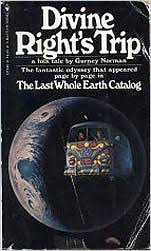Gurney Norman's first and only novel, Divine Right's Trip was initially printed in 1971 in the margins of The Last Whole Earth Catalog - Stewart Brand's wildly popular catalog of materials that hippie communes had found useful. In 1972, it was published in hardback by Dial Press of New York, and in this mass market paperback edition that same year. The cover to this edition features a picture, of Urge, the VW Microbus with a psychedelic paint job that figures prominently in this novel, emerging from a picture of the earth as depicted on the cover of the Last Whole Earth Catalog. Divine Right's Trip became so iconic that it it known by its initials - DRT. It was one of the first important novels published that featured hippie characters. Estelle and D. R. are driving Urge from California, where they had participated in hippie culture, back to Eastern Kentucky where they had grown up. Their goal is to raise rabbits back home and use their excrement to reclaim strip mines. "Divine Right's Trip shows itself to be a subtly written and morally passionate epic of the counterculture, a fictional explication of the hopeful new consciousness come to birth. Divine Right is bigger than life, and in giving the story thus far of a segment of his generation, in prose nicely threaded between the vernacular and the symbolic, Gurney Norman has shown a noble reach and a healthy grasp." - John Updike. Gurney Norman was born in Southwest Virginia, but his parents suffered from mental illness,and his father died young, so he spent most of his youth in Allais, a coal camp in Perry County, Kentucky, near Hazard, where his paternal grandfather had run the company store. He went to high school at the Stuart Robinson School in nearby Letcher County, a boarding school. While he was there, his brother, who Gurney idealized, died in a jeep wreck. Norman graduated from the University of Kentucky, and in 1960 he was chosen for a prestigious Wallace Stegner Fellowship at Stanford University. After Stanford, he went into the Army, then got a job with The Hazard Herald, and worked in the summers as a fire tower lookout in the Cascade Mountains. Those experiences gave him the time of complete the manuscript for DRT and get it published. In 1977 he published Kinfolks, a collection of inter-related short stories that is viewed as one of the foremost portrayals of hill-folk in the seventies. Yes, the same person so adept at characterizing hippies was a master at making mountain folk come to life. He had participated in both cultures. In 1979 Gurney Norman started teaching at the University of Kentucky. Now in his eighties, he continues to teach creative writing there. Just yesterday I was talking with a young Eastern Kentucky woman who said that years ago she sent a sample of her writing to Gurney Norman, who she had never met, and that the next day he had read it and gave her many suggestions and complements. She is not the only one - not by a long shot.
New York: Bantam Book/Dial Press, 1972. 302 pages. Mass market paperback.
